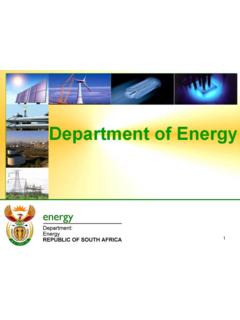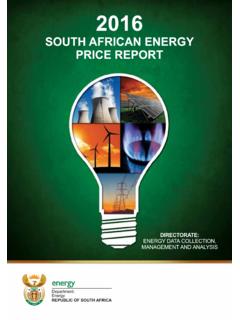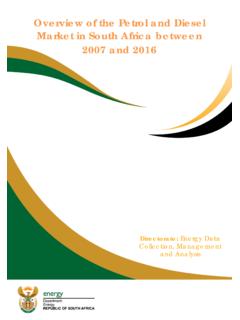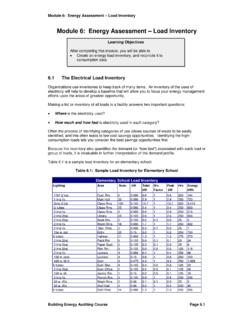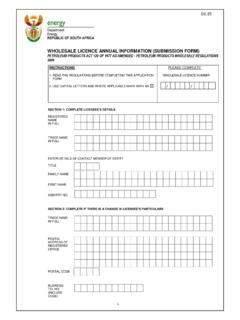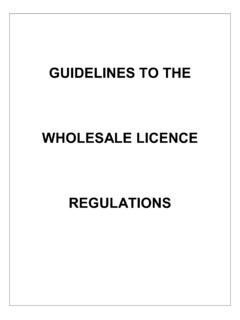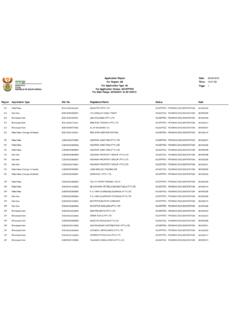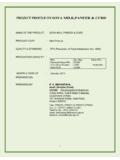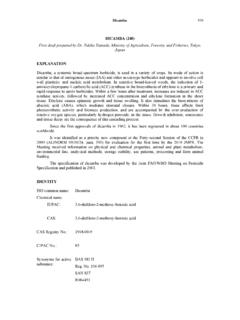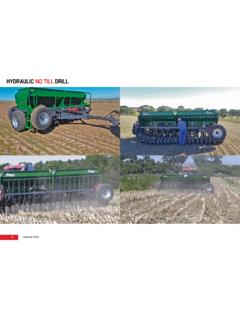Transcription of BIOFUELS PRICING AND MANUFACTURING ECONOMICS
1 1. BIOFUELS PRICING AND MANUFACTURING ECONOMICS . Bioethanol is now a common fuel component that is blended in the petrol pools of many countries. Total world production is about 80 million tonnes per annum, with the US and Brazil being the leading producers. Bioethanol is manufactured by fermentation of starchy or sugary raw materials through well-established first generation technology. The most common raw materials are maize and sugar cane. Analysis of potential commercial ethanol feedstocks in South Africa reveals that grain sorghum and sugar cane are the leading contenders. Maize is also a suitable feedstock, but its use for ethanol production is banned in South Africa. Sorghum used to be cultivated extensively, but production declined as the local market demand for sorghum decreased.
2 However, large parts of South Africa are well-suited to sorghum cultivation (more than for maize) and its drought- resistant properties make it an attractive crop, for example as a feedstock for local ethanol manufacture. Large quantities of sugar cane and sugar are produced locally, mostly in KwaZulu- Natal, and about 40% of sugar production is exported. Unlike sorghum, the potential for significant expansion of sugar cane cultivation is limited and its high water requirements are a constraint in a water-scarce country like South Africa. Sugar beet, in particular tropical sugar beet, has been proposed as a potential feedstock for bioethanol manufacture. Unfortunately, there is no reliable, public domain information available on sugar beet in South Africa, and for this reason any attempt to construct a rigorous economic model based on sugar beet as feedstock would be speculative and subject to a high degree of uncertainly and error.
3 While not analysed, continued research and development of tropical sugar beet is worthwhile and the crop may prove to be a competitive feedstock source in the future. Both grain sorghum and sugar cane feedstocks are analysed in terms of supply and demand, markets, costs and PRICING . The co-products from ethanol production from sorghum and cane, namely distillers grains and solubles (DGS) and green, renewable electricity, respectively, are also analysed. Based on these analyses, a high level consideration of the net raw material costs for ethanol production (the largest cost component) indicates that ethanol production from sugar cane, whether rain-fed or irrigated, is much more expensive than from grain sorghum. For a number of reasons grain sorghum is the most favourable feedstock for local ethanol manufacture.
4 The technology for production of ethanol from both feedstocks is described and the efficient MANUFACTURING plant capacities have been elucidated. The minimum recommended plant capacities are 158,000 m3/a in the case of sorghum and 95,000 m3/a for sugar cane. The capital investment for these plants are R2,131 million and R1,973 million, respectively. A sugar cane to ethanol plant is about 25% more expensive than a sorghum plant of the same size. These plants were chosen as the reference plants for further study. Mass balances, process chemical and utility requirements, labour requirements and the other fixed and indirect costs involved in operating an ethanol business are presented. The land size, plot plan, infrastructure and logistics requirements, and asset base are also given.
5 A number of methods are suitable for determining the financial returns of a project or business. Return on Investment (ROI), Return on Assets (ROA), Internal Rate of Return (IRR) and 2. economic Value Added (EVA) are described and compared. After considering the advantages and disadvantages of each, it was decided that ROA provides the best measure for the specific task of calculating a financial return for the reference biofuel MANUFACTURING plant and determining the level of government support needed. The Marketing of Petroleum Activities Return (MPAR) framework, which also uses ROA, provides a useful methodology that can be applied to the BIOFUELS industry and a target ROA level of 15% was chosen as the basis for establishing the level of support.
6 The Excel financial model comprises a number of worksheets that are organised in such a way that it is easy to update the model periodically. The worksheets are described and instructions are given on how to use the model. The initial version of the model is populated with historical data for the calendar year 2010. The output of the model describes how a business based on the reference plants (158,000 m3/a ethanol from grain sorghum or 95,000 m3/a ethanol from sugar cane) would have performed during the period. For sorghum it reveals that the average ROA that would have been obtained was and the level of additional support required for a 15% ROA would have been 270 c/l. (Note that there are no fuel tax rebates for fuel ethanol).
7 The ROA ranges from to on a monthly basis. The results of the economic model for ethanol production from sugar cane are quite different. The average ROA is , ranging from to The average level of support needed to yield a 15% ROA is 563 c/l. This underscores the previous conclusions that sugar cane is not a favourable feedstock for ethanol manufacture in South Africa. The most sensitive variables are the selling price of fuel ethanol, which is related to the BFP, and the cost of feedstock. The goal of the economic model for ethanol manufacture is to determine the quantum of government support required to encourage investment in BIOFUELS . The value of the producer incentive to yield a specific ROA will depend on prices in the market, which are constantly changing.
8 Therefore, the model needs to be updated periodically to reflect the market. The basis for the updates is described and all the variables that need to be updated regularly are contained in one worksheet of the model, namely the Producer Price Index (PPI), the Consumer Price Index (CPI), the fuel tax rebates for fuel ethanol blending, the Basic Fuel Price (BFP) for Mogas 95, the ZAR/USD exchange rate, the SAFEX yellow maize price and the ICE raw sugar price. The first three variables should be changed on an annual basis and the latter four variables on a monthly basis. High-level working rules to administer the updates and determine the producer incentive are proposed. A ceiling on the level of support that is linked to the cost of job creation is also proposed.
9 Using the cost of fuel attendant jobs at service station forecourts as a proxy for the cost of job creation in the fuel industry, the maximum level of producer incentive for bioethanol manufacture should be per litre. Since its first commercial production in the late 1980s, biodiesel manufacture has grown exponentially and biodiesel is now commonly used as a blending component with fossil diesel. Total world production was estimated at over 40 billion litres in 2010. Biodiesel is manufactured by the transesterification of vegetable oils. The most common feedstocks are soya oil (in the US) and rapeseed oil (in the EU). Analysis of potential biodiesel feedstocks in South Africa reveals that soya beans and sunflower seed are candidates.
10 Both potential feedstocks are analysed in terms of supply and demand, costs, and PRICING . The co-product of oilseed crushing is a protein meal or oilcake, which is used 3. in animal feeds. The by-product from biodiesel manufacture is glycerol. The markets for these products are analysed in detail. soya meal is much more valuable than sunflower oilcake because of the high protein content, low fibre content and better amino acid profile of soya meal. Over million tonnes of soya meal are imported annually to satisfy local demand as local production is only about million tonnes. In contrast, the supply of sunflower oilcake is more or less in balance with demand, with very little imports to supplement local production of million tonnes.

